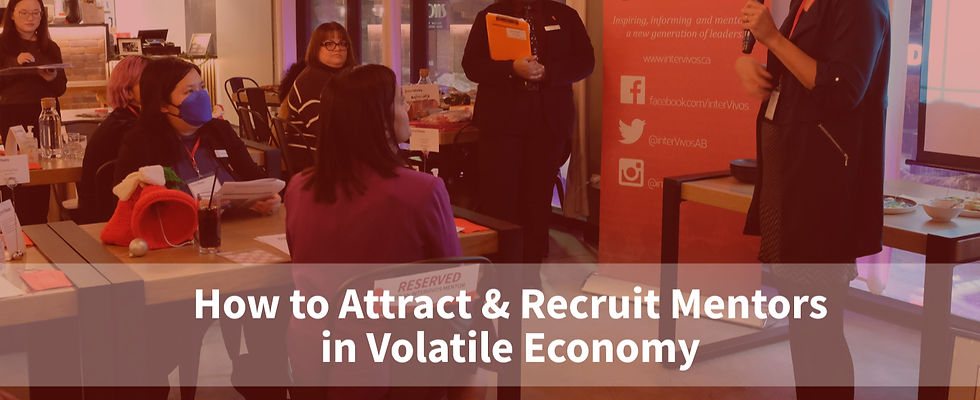Building a Professional or Personal Mentoring Program for Millennials
- connect interVivos
- Nov 20, 2018
- 3 min read
Mentoring is an important aspect of entering the workforce as a millennial, although it is often neglected, even by business owners themselves. While many millennials frequently do well without extra assistance, they can do so through extra effort and work on their part. Many from this generation, however, either lack the opportunity or the will to perform better. As a result, they often require an extra push, or mentoring once they’ve graduated from school.
Are millennials really any different than past generations? It’s true to say that some of the behaviours and attributes of millennials can be explained by their age and limited or lack of experience. However, one of the defining characteristics of the millennial generation is their affinity with the digital world, and their expectations about how technology is used in the workplace. Plus, they need a workplace culture that is robust, flexible, innovative, and a management style and approach that is not restrained by “how things used to be done.” Millennials value a work/life balance, they expect regular detailed feedback and encouragement, and need to feel that their work is worthwhile and that their efforts are being recognized.
Implementing mentoring programs after school-life
Although recognized as an important part of certain academic programs and processes, mentoring remains one of the least understood practices in many corporate institutions. If not implemented properly, a mentoring program can become under-utilized, mismanaged, or even turn out to be a costly yet ineffective endeavor for those involved. To have a positive, successful impact in the design, and implementation of mentoring programs within the corporate or private structure, we need to think and maneuver differently when mentoring millennials. There are key considerations that must be kept in mind:
Proper planning
The goal of mentoring is to improve performance in both personal and professional development, and to ensure that protégés are well-prepared for interaction with their social and professional environments. It is important that an organization, including the mentor and protégé understands what they wish to attain through the mentoring programs by ensuring that qualitative and quantitative standards are in place.
Goals and objectives of the mentoring program, and the mentoring relationship must also be specific, well-structured, and facilitated to allow those implementing the program to determine whether the procedures are being followed, and outcomes achieved. This is important if compliance is an issue in a workplace mentorship program.
Building the core group or staff
A mentoring program within a millennial’s personal or professional life will be more effective when a central core of experienced and dedicated people are on hand to design, implement, and assess it. This will help ensure a well-organized program that is easy to monitor and run.
Recruitment of mentors
The type and quality of mentors to be chosen for the program is indicative of its success. Mentors may be selected through volunteer programs, where other employees and even members of public life can sign up for the task. Mentors could also be selected through active recruitment where they are sought out from the community at-large and asked to join.
A set of qualifications may be set in order for mentors to meet quality standards and to help streamline the application process.
Screening for mentors
The next step in creating any mentoring program is to screen the mentors for eligibility. After reviewing the applications, the core group or staff can begin interviewing the mentor applicants to determine their fit for the program. This is especially important when there are certain activities that may require extra tasks for the mentors or the protégés.
Training for mentors
An important part of a mentoring program is mentor training. Just because a person is qualified does not make them a perfect candidate for mentorship. Mentors must be able to understand the goals and objectives of the program, and be informed about any limitations and boundaries. Certain communication skills must also be checked or improved if necessary.
Matching mentors with protégés
As one of the final steps in implementing a program for mentoring, pairing mentors with protégés can be a challenge given that multi-generations are involved. Therefore, it is important that this is considered carefully. While there are no set standards for pairing, most experts suggest it’s best to consider personality and mentoring styles in order to create the perfect match. If a certain match proves to be ineffective, corrections must be implemented immediately.
A mentoring program can be an extremely rewarding experience and a mutually beneficial relationship for both mentor and protégé. The exchange of information can assist not only the protégé, but also the mentor. We are never too old, young or too successful to learn. What are you waiting for?
To Your Success!
Janice Sarich, M.Ed. President, It Begins With You Inc. Former MLA Edmonton-Decore & Parliamentary Assistant to Education Minister



Melissa Scott, MA
Janice (Mentor) and Melissa (Protégé) participated in the Spring 2018 mentorship program and wrote this blog together for our website.











Comments